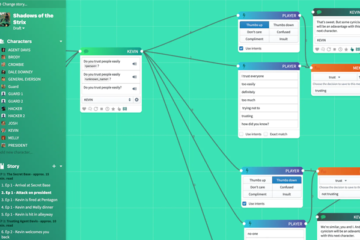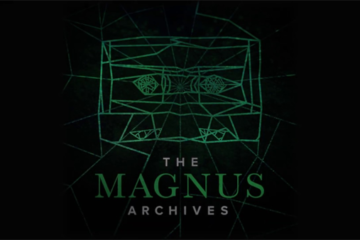Charisma.ai helps you create interactive stories, believable characters, and learn how to work with non-linear storytelling. Meet Guy Gadney, its CEO, and find out more about the work they’re doing.
In the first part of this article, we introduced the work that Charisma.ai, a British company founded by Annette Parry, Ben Salili-James and Guy Gadney, is doing in the field of interactive storytelling and characters writing. In particular, we tried to unravel some connections to fan culture and the approach that fans have to media in general.
Using AI and the most advanced NLP technologies, Charisma.ai develops interactive films and TV series, games and VR experiences, educational and healthcare tools that always focus on the most important rule of good storytelling: making the audience feel part of the story and helping them relate to its main characters, who are at the heart of Charisma.ai’s productions and research.
Charisma.ai’s focus on creating believable and emotional characters can be seen in the careful way their tools allow writers to work with elements like memories, emotions, and natural dialogue in order to create stories that readers can feel a connection with.
After trying out Charisma.ai’s app (available for free – see the end of this article for references), enjoying their interactive Sherlock Holmes comics, and experimenting with my own narrative map, I reached out to CEO Guy Gadney to discuss with him the work his company is doing.
Getting to know interactive storytelling: an interview with Charisma.AI CEO, Guy Gadney
When I joined your panel at HOPE! Creative Forum I was immensely fascinated by the work Charisma.ai is doing in relation to non-linear storytelling using AI. In some ways it’s deeply related to what fans are looking for. I also often hear people refer to this kind of approach in the field of virtual reality. What can you tell me about that?
GUY GADNEY – XR (extended reality) and specifically VR has mostly explored visual storytelling. A lot of the people who were drawn to VR were filmmakers, people who were used to making movies and to some extent games, but still exploring visual languages. I think there’s another layer to storytelling, which is actually the story language that’s underneath the visual language that sometimes gets ignored because it’s really hard to work with.
Part of the reason it’s hard is pretty obvious: it’s more difficult to work on multiple things at the same time than it is to focus on just one. That’s why it’s a given that it’s going to be easier to write a single linear script than to develop all the different storylines. It becomes creatively very challenging for a lot of people who are used to working in a very linear visual medium, like film.
However, as you move into a more interactive space, AI (artificial intelligence) can help because it can semi-automate the writing process. It can help you lift the heavy weight of complexity. And that’s why we built Charisma.ai: we recognized that if you’re really going to do proper storytelling, you need the proper tools to do it.
Just like with anything else: if you’re making pottery, if you’re making art, if you’re making music, you need the right tool for the right job. And it’s the same with technology. You can’t use Microsoft Word to create an interactive story. It doesn’t work. So you have to ask yourself, why not? Why can’t I write a truly interactive and engaging story in Word? And the answer is creative: what do I want to write and how do I want to write it? Only when you answer it, do you define the right tool.
Branching storylines are an essential part of how fans experience their passion for media. They write endless versions of the same story, fanfictions, to analyze “how things might have turned out if…”. Why is it so important to have multiple endings and multiple choices, in your opinion?
I think it is an intellectual engagement. It’s not an engagement of the heart, nor an engagement of the emotions. If you want to know how to engage the heart, which is surely the basis of a lot of storytelling, you should look at theater: theater is interesting because of our proximity to the story. When you go to the theater, you can measure where you are in relation to the story: I am two meters from the story. I am two meters away from the actors. In immersive theater, I’m in the story. The theater industry has been thinking about proximity and its emotional impact for quite some time… and that’s why you pay more for being closer to the stage. The greater value of proximity, in my opinion, has nothing to do with your sight. It’s about the experience of being closer to the story.
As we look at the structure of interactive storytelling, we have to think about what’s there for the brain and the mind and the intellectual stimulus, and then what’s actually going to make us feel something. That’s why we build Charisma.ai: because we recognize that one of the ways to do that is to be very natural and have natural language conversations, which is what allows us to build a relationship with someone, like the one you and me are creating the longer we talk.
Characters are an essential element of storytelling and Charisma.ai really focuses on their development, right?
We are completing a research paper with the University of Southern California that looks at what a character model would look like in interactive media. It’s fairly clear what a character model looks like in movies or in literature or in theater because they are well-established media, but in interactivity it’s newer. So, we tried to figure out how to design a character. However, with this research, we’re not trying to be totally prescriptive. We don’t want to say “you have to do this,” but just “these are the things you need to think about if you’re designing a character for an interactive story”.
For example, one thing you need to consider is the relationship of the audience with the character. In interactive media, this relationship is even more important than in a book or a film, because the audience now has a relationship with the character that is tangible.
Also, you have to think about the duration of the character. In a book it might be 200 pages, in a film it might be 100 minutes, in a TV series it might be seven hours. But if you’re talking about interactivity, the relationship you have with that character could last months, years! So how do you design a character that can grow with the story over such a long time? These are new concepts that are coming up. In many ways, the game industry is thinking about this because of online multiplayer games, which have story lines running for years with incredible persistence.
We have to think about all these creative aspects and I think it is an incredible challenge for creatives.
Is the paper already available?
The paper will be published soon and I hear that it is already sparking debate around this topic, which makes me really happy. More than anything else, what we want is for people to start thinking aout this. Properly creative thinking is the whole purpose of the paper. As said, we don’t want to provide a solution, but a series of topics that people can discuss and draw a map around.
One of the problems I have often found in Italy is a general lack of interest, often even academic, in these issues. How is the situation in England?
In the UK we have this concept of creative clusters, which is how I started working with XRStories and why I was doing the transmedia theater conference that you signed up for. It was a government research initiative, quite focused on the future of storytelling across publishing, AI, film, TV, games. So the UK is doing something to help people think about that.
The problem is that this is all very VR focused, and as I said VR is very superficial in the way it looks at storytelling. You need to go down into the DNA of storytelling, to find its essence… and that’s more difficult. The reason why the University of Southern California could look at it is because that University and specifically their Entertainment Technology Center are funded by big American studios and organizations, so they’re looking ahead. America is looking ahead. After all, they invented Netflix, they have Amazon Prime, they have the Hollywood Studios. They have this dominant media ecosystems.
I would like us here in Europe to be able not only to think more creatively but to do more creatively. Build the platforms, build the Netflix-es. At Charisma.ai we’ve tried to do that, but as a small company there’s only so much we can do to advance the medium.
I think there are people looking at some really exciting things and there are really exciting EU funding projects for some very futuristic ideas. My concern is that they will be Academia-focused prototypes, rather than sustainable business models. But at the same time we’re very creative people and we are very good storytellers. If the creative industries and creative people embraced technology and saw it as a new form of storytelling, rather than something that’s not relevant to them, that would be amazing.
I so agree with you! But it’s rare to see people who take the risk, creatively speaking.
For some reason, Umberto Eco just popped into my head. The name of the Rose is a fantastic non-linear novel, and its characters are brilliant. The architecture of the Abbey is perfectly suited to exploration. Likewise, the magical realists of Latin America: Gabriel García Márquez, Isabel Allende and the like. They create worlds and characters that work brilliantly in space. e. However, for some reason, it is rare to find a writer now who is willing to take this risk. I hope we can start to see not just experiments, but complete, really well-funded developments. There’s no reason why it can’t be done, except maybe…. well, not even money. More like the will and desire of the big media organisations.
If you want an example of that, you can see it again with Netflix and the interactive version of Black Mirror, Black Mirror: Bandersnatch. When they did that, they changed the industry and suddenly everyone was interested in that.
If you look at the media ecosystem in Europe and UK – Sky Italia, Sky TV, the Nordic TV production companies… these people are now at a point where they need to be more competitive than they are, because they are losing viewers and subscribers to Netflix and Amazon. They need to be adventurous and it’s very clear where the audience is and how they consume media: they want to be closer to the story and they want to be part of the story. So allow them to do that!
Especially because the audience can really make a difference. Look at what happened with Star Wars: nobody believed in it and yet the fans loved it so much, that we’re still producing films about it 40 years later, new TV series, anime… It’s right in front of us: bringing the audience into the story is the future of entertainment.
It’s the future, but it is also the past! This is important to remember. If you go back in time, the story has always been more important than the author. Before Gutenberg’s printing press, stories were fluid. Troubadours travelled around Europe and listened to the events happening in small towns, and then the story they told the next day was influenced by the gossip they had heard.
So yes, stories are very fluid and they involve the reader, the audience. It was only when the book came that the stories were set in print in a rigid way and… got trapped somehow. It’s like with the Brothers Grimm and the fairy tales. They didn’t invent those stories, they captured them and wrote them down. So, I think you’re right to say that it’s new and it’s the future… but it is also very old!
I was fascinated by the narrative map you can create via the Charisma.ai platform. After understanding the dynamics, it became really exciting to visualise the different directions my story could take!
It’s a bit of an experiment. When you create your story you generate a structure that you can see on your screen: all the little boxes, the notes, the connections between the different parts… Every writer creates a different structure. It’s like a map of your mind, of how you tell stories. Some produce a “traditional” map, others make the chart in crazy ways, giving it an almost circular look. Each story, in its structure, is like a snowflake: they’re all different. Once you have your momentum on how the structure works, you start playing with it, and the moment we start playing, as has always been the case with human beings, is when the creativity really kicks in.
It is also a great way to learn more about human behaviour. You have to visualise how your characters – but also your readers! – would respond to something and really learn to get inside their minds.
Using the Charisma.ai platform, we also did a version of Shakespeare for school children, in collaboration with the University of Oxford. Will Play uses a very simple Instagram approach to make children feel closer to the characters and to help them better understand their motivations, but in a way that is familiar to them.

It’s a very psychological approach.
In all the things we do, the way we approach conversations is psychological. So much in conversations is a game, whether it’s the police interrogation or a seduction, whether it’s asking for a pay rise or trying to get a new job. It’s all a game. For this reason, if you were to map such a conversation into a story, you would need to plan it carefully. You wouldn’t want certain things to be revealed too early. Like in the Agatha Christie books, you have to wait before revealing your characters’ secrets. This is a bit of a challenge with the AI.
Why?
When you use really advanced AI, such as the automatic content generator GPT-3, you need to direct it through prompts. You give it a context. In some ways it’s like what a Dungeon Master does: the spine, the core of the story that the Dungeon Master creates is the prompt we feed to the AI and the AI generates the narrative from that. That’s great… but it is also probable that at some point GPT-3 or any of these AI systems will generate a piece of text that contradicts the story world in some way.
Let’s use the example of Agatha Christie. If I feed the AI the context that a certain person is the murderer and that this person has a relationship with someone else and this someone else doesn’t like someone else and so on… I am training GPT-3 on this. GPT-3 could then come back with a response saying, “This person is the murderer and this is why the murder happens!”… but I don’t want this revelation to happen so soon, I want a long con. So what’s really tricky is creating content that’s appropriate for the story at that moment in time. And that’s what we’re exploring.
I read on your blog that Charisma.ai recently launched the AI Consortium. Why did you do this?
At the moment, we have set up the base of the AI Consortium, which is great, and now we are waiting for some funding opportunities. My key mission is to help creatives in the creative industries have a seat at the table in these discussions around technology. We don’t just want technology developed by Microsoft or Google, because it’s not useful to us. We need brushes that look like brushes and not sticks, which is what we’re going to get if we leave everything in the hands of tech companies.
You see, years ago, after a degree in Latin American Literature, I did a a degree in philosophy. At that time philosophy wasn’t cool, it was not trendy. Actually, it was very depressing from the outside! But now, with AI and all the related topics, philosophy is back and has become a hot thing to study.
I hope the same happens with creative technology. That it becomes a hot thing to look at as people start to realise that you can’t just create technology that doesn’t think about people and art.
Just think of the gender or racial bias in some platforms. They shouldn’t be there, but it’s pretty obvious why they’re there: they’re coded by young white guys in Silicon Valley. There’s going to be bias because that’s how it’s been coded, it’s intrinsic to it. This is something to think about!
We at Fanheart3 may not be tech-savvy, as some say, but we loved even more what Charisma.ai is doing and the focus it is putting on the creative and not only on the technical aspects.
Check out their interactive comics and app, which you can download for free in the App Store and Google Play. Visit their website to find out more about what they’re working on and to experiment with the platform that will allow you to create your own narrative map. It’s mind-blowing – and quite inspiring. It will certainly help many a writer among you to really understand your characters and imagine all the possible directions in which their choices will take your story.
Special thanks to Guy Gadney for sharing this insight with fanheart3 and to AI for… well, not stabbing us in the back yet, I guess. *NextMode:Off*

